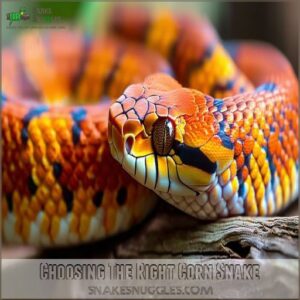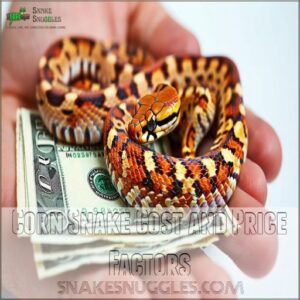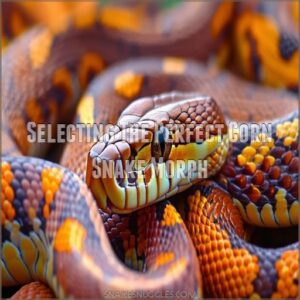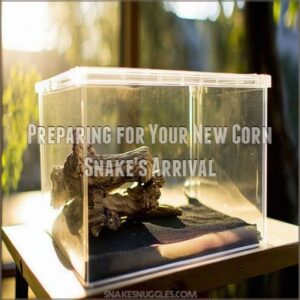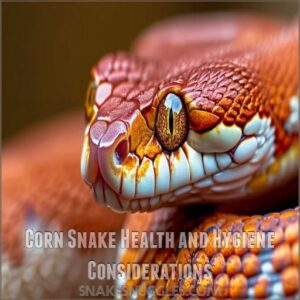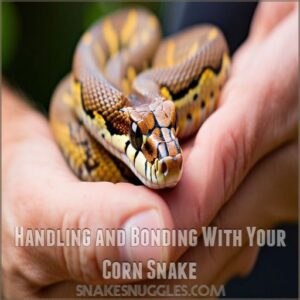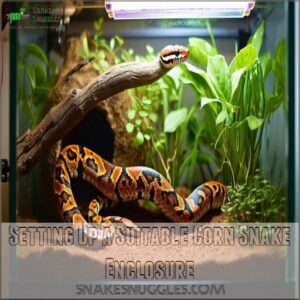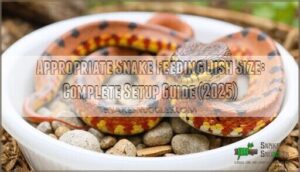This site is supported by our readers. We may earn a commission, at no cost to you, if you purchase through links.
 You’ll need to be smart and selective when you buy a corn snake, just like picking the perfect dance partner.
You’ll need to be smart and selective when you buy a corn snake, just like picking the perfect dance partner.
Start by finding a reputable breeder who offers captive-bred snakes – they’re healthier and better socialized than wild-caught specimens.
Look for a snake that’s alert, has clear eyes, and shows no signs of retained skin or respiratory issues.
You can expect to invest $50-500 for the snake itself, plus about $300 for a proper habitat setup.
Remember, a healthy corn snake can be your companion for up to 20 years, so choose one with a gentle temperament that matches your experience level.
Table Of Contents
- Key Takeaways
- Choosing The Right Corn Snake
- How to Buy a Corn Snake Online Safely
- Corn Snake Cost and Price Factors
- Selecting The Perfect Corn Snake Morph
- Preparing for Your New Corn Snake’s Arrival
- Corn Snake Health and Hygiene Considerations
- Handling and Bonding With Your Corn Snake
- Setting Up a Suitable Corn Snake Enclosure
- Feeding and Nutrition for Your Corn Snake
- Post-Purchase Care and Support
- Frequently Asked Questions (FAQs)
- Which corn snakes are available for sale?
- Can you buy a corn snake online?
- Can you buy a scaleless corn snake online?
- Can a baby corn snake be used for an adult corn snake?
- Is a corn snake a good first pet snake?
- How much does a corn snake cost?
- What to look for when buying a corn snake?
- How do you get a corn snake as a pet?
- Are corn snakes good for beginners?
- Can I hold my corn snake when I first get it?
- Can corn snakes live with other pet snakes?
- How old do corn snakes typically live?
- Do corn snakes recognize their owners?
- When do corn snakes reach full size?
- Are corn snakes good pets for apartments?
- Conclusion
Key Takeaways
Here are 4 key takeaways on how to buy a corn snake:
- Find a reputable breeder who offers healthy, captive-bred snakes and provides detailed care instructions, breeding lineage, and health guarantees.
- Consider the snake’s temperament, color morph, and rarity to choose the right companion that fits your experience level and preferences.
- Set up the proper 30-gallon enclosure with a temperature gradient, humidity control, and enrichment items before your new snake arrives.
- Establish a feeding routine based on your corn snake’s age, offering appropriately sized prey every 1-3 weeks, and maintain a clean, stress-free environment.
Choosing The Right Corn Snake
Choosing the right corn snake is like picking the perfect pair of shoes—you’ve got to make sure it fits your lifestyle and personality.
You’ll need to think about their lifespan, temperament, and the variety of stunning color morphs available, all while finding a reputable breeder to guarantee a healthy pet.
Researching Corn Snake Lifespan and Care
Before diving into corn snake ownership, you’ll want to get the scoop on their impressive 15-20 year lifespan.
These hardy reptiles thrive with proper care: a well-maintained 30-gallon tank, steady temperatures between 75-90°F, which can be achieved with a reliable corn snake heat mat, and 40-50% humidity.
You’ll need to feed them appropriately sized mice every 2-3 weeks as adults, and make sure they’ve got clean water daily for a long, healthy life.
Learning About Corn Snake Behavior and Temperament
Corn snakes are gentle and easygoing, making them a top pick for beginners.
They’re like the laid-back friend who’s always up for a chill hangout.
When handling them, remember to move slowly—like you’re sneaking the last cookie—and watch for stress signs like hissing.
Providing basic care and gradual social interaction helps them thrive.
Discovering The Different Types of Corn Snakes
Now that you understand their friendly nature, let’s explore the incredible variety of corn snakes.
These snakes come in stunning color morphs and patterns – from classic wild-type oranges to striking albinos and mesmerizing motley patterns.
Each morph has unique genetic variations that determine their appearance, and breeders use tools like a morph calculator exploring the world of corn snake morphs to predict the outcomes of specific pairings.
You’ll find everything from snow-white beauties to rich caramel-colored specimens, with some rare patterns fetching premium prices.
Finding a Reputable Corn Snake Breeder
When searching for your corn snake companion, partnering with a reputable breeder makes all the difference.
Look for breeders with at least five years of experience and transparent health records.
You’ll want to check their customer reviews, visit their facility if possible, and ask about their breeding practices.
Don’t shy away from asking tough questions – ethical breeders welcome them and prioritize their snakes’ wellbeing over quick sales.
How to Buy a Corn Snake Online Safely
You’ll find buying a corn snake online isn’t as tricky as it sounds, especially when you know how to spot reliable breeders who offer health guarantees and detailed care instructions.
While scrolling through endless morphs and photos might feel like online shoe shopping, you’ll need to focus on finding a reputable seller who provides complete documentation of the snake’s history, feeding records, and genetic background.
Looking for Breeders With a Good Reputation
Finding a trustworthy breeder is like choosing a partner in your snake-keeping journey.
Many breeders also sell products related to Corn snake lineage online.
Start by checking reptile forums and social media groups where experienced keepers share their experiences.
Look for breeders who openly discuss their breeding practices, provide detailed lineage histories, and maintain active engagement with the reptile community.
Local reptile shows offer great opportunities to meet breeders face-to-face and see their animals firsthand.
Checking for Health Guarantees and Return Policies
A reputable breeder’s health guarantee is like a safety net for your new scaly friend.
Look for sellers who offer at least a 48-hour live arrival guarantee and clear return policies.
The best breeders provide detailed health records, recent photos, and documented proof of regular vet check-ups.
Don’t hesitate to ask for written confirmation of these policies—it’s your right as a buyer.
Asking About Feeding and Care Instructions
A responsible breeder will provide detailed instructions about your corn snake’s feeding schedule, including its specific dietary needs and optimal corn snake feeding routine. A responsible breeder will provide detailed instructions about your corn snake’s feeding schedule and care needs.
Ask about their feeding record – what size prey they’re eating and how often they feed.
Don’t forget to discuss their water requirements, preferred enclosure setup, and handling preferences.
Getting these specifics upfront helps you prepare the perfect home for your new pet’s arrival.
Inquiring About The Snake’s History and Genetics
Everyone wants to know their snake’s family tree.
Ask your breeder about the corn snake’s breeding lineage, genetic health history, and morph origins.
You’ll want details about any inherited traits or potential health issues that could pop up down the line.
Reputable breeders keep detailed records of their breeding programs and will happily share this information with you.
Corn Snake Cost and Price Factors
You’ll need to budget between $50 and $500 for your corn snake depending on its color morph, size, and genetics.
Essential supplies like housing, heating, and feeding equipment will cost another $300 to $1,000.
Understanding these costs upfront will help you make a smart choice and guarantee you’re ready to provide the best care for your new scaly friend.
Factors Affecting Corn Snake Prices
From the most basic varieties to rare designer morphs, corn snake prices can vary dramatically based on several key factors.
Your perfect serpentine companion’s cost will primarily depend on:
- Color morph rarity and genetic traits
- Age of the snake and breeding potential
- Breeder’s reputation and health guarantees
High-end morphs from established breeders might set you back $500+, while common varieties typically range from $50-150.
Cost of Corn Snake Care and Maintenance
You’ll need to budget for ongoing care expenses that keep your corn snake healthy and happy.
Essential monthly costs include substrate replacement ($10-15), frozen mice ($15-20), and utilities for heating and lighting ($10-25).
Initially, expect to invest in a basic enclosure setup, including a proper terrarium, heating equipment, and accessories, which can start around $300-500, depending on the snake’s specific needs and factors affecting cost.
Regular vet check-ups typically run $50-75 annually.
Hidden Costs of Owning a Corn Snake
Beyond the initial cost, owning a corn snake involves ongoing expenses.
Regular vet checkups are important; unexpected illnesses can pop up.
Enclosure upgrades, like a bigger tank as your snake grows, add up.
Consistent heating and humidity control mean ongoing electricity costs.
Don’t forget food costs; mice and rats add up over time!
Planning for these hidden costs helps make sure your scaly friend thrives.
Selecting The Perfect Corn Snake Morph
With so many beautiful corn snake color variations, you’ll be spoiled for choice.
From the classic orange and black to the rare and mesmerizing albino or anerythristic morphs, finding your perfect reptile companion is an exciting part of the process.
Rare and Unique Corn Snake Morphs
While typical corn snakes come in a range of browns and oranges, captive breeding has opened up a stunning array of rare morphs, including the highly sought after albino corn snake morph, which boasts vibrant yellow or orange coloration.
From iridescent lavenders to ghostly albinos, these unique patterns and hues can command premium prices.
Explore specialized breeding programs to find your one-of-a-kind companion.
Choosing The Right Color Morph for You
With countless color morphs to choose from, selecting the right corn snake for you comes down to personal preference.
Consider your favorite hues, how much you value rarity, and any special care needs for certain morphs.
Some are more costly, but their unique appearances may be worth it for passionate reptile enthusiasts.
Preparing for Your New Corn Snake’s Arrival
Preparing for your new corn snake’s arrival takes planning and patience.
From assembling the right enclosure to mastering feeding techniques, you’ll want to make sure your new scaly friend has everything it needs to thrive in its new home.
Setting Up The Right Enclosure and Equipment
Before setting up your new corn snake’s home, gather the essential supplies.
Start with a spacious 30-gallon terrarium, then add a temperature gradient using a thermostat-controlled heating pad.
Finally, choose an appropriate substrate like aspen shavings to maintain the ideal 40-50% humidity levels.
With the right enclosure setup, your corn snake will thrive.
Learning About Proper Feeding and Care Techniques
Every corn snake owner knows the secret to a happy snake lies in feeding and care techniques.
Offer a well-rounded corn snake diet, with feeding frequency every 1-2 weeks.
Make sure a fresh water bowl is always available.
Keep your temperature gradient just right, and choose a substrate that’s soft and comfortable.
Master these tips, and you’ve got a thriving pet!
Understanding The Snake’s Habitat and Environmental Needs
Got your snake’s feeding sorted? Now, think about their new digs. You’ll need an enclosure with the right temperature and humidity. Corn snakes love a cozy setup: For a detailed guide, check out a thorough corn snake enclosure setup.
- Basking area: Hot as a summer day, around 90°F.
- Cool zone: Like spring, at 75°F.
- Humidity: Keep it 40-50%.
- Substrate: Aspen shavings or coconut fiber.
- Enrichment: Branches and hides for exploring.
Corn Snake Health and Hygiene Considerations
Caring for a corn snake’s health and hygiene is essential to their wellbeing. To ensure a long and healthy life, follow a comprehensive corn snake care guide that covers common health issues, temperature, and humidity requirements. Caring for a corn snake’s health and hygiene is essential to their wellbeing.
You’ll need to watch out for common issues like poor shedding and skin infections.
Keep their habitat spotless to prevent problems.
Common Health Issues in Corn Snakes
Corn snakes are generally hardy, but can sometimes face health challenges.
Common issues include shedding problems, scale rot, respiratory infections, and parasites.
Stay alert for signs of distress like lethargy, dull coloration, or trouble breathing.
With proper husbandry and quick action, most corn snake health problems can be quickly resolved.
Preventing Dysecdysis and Pustular Dermatitis
Maintaining ideal humidity levels and providing a clean, comfortable environment are essential for preventing two common corn snake health issues – dysecdysis (poor shedding) and pustular dermatitis (scale rot).
Here are 4 tips to keep your slithery friend in tip-top shape:
- Monitor humidity levels closely, keeping them between 40-50%.
- Make sure you have the right substrate, water sources, and hides to facilitate healthy shedding.
- Spot clean the enclosure regularly to prevent bacterial buildup.
- Quarantine new snakes and disinfect the habitat before introducing them.
Maintaining a Clean and Healthy Environment
The right terrarium setup goes a long way in keeping your corn snake happy and healthy.
Opt for a high-quality substrate that allows proper humidity levels and air flow.
Regularly spot-clean the enclosure and perform a deep clean every 2-4 weeks to prevent bacteria buildup.
Maintaining a pristine environment is key to your corn snake’s wellbeing.
Handling and Bonding With Your Corn Snake
Building trust with your corn snake is key. Spend time gently handling your new pet to help it become comfortable and bond with you.
Tips for Handling Your Corn Snake Safely
Gently scoop your corn snake from below, supporting its whole body.
Avoid grabbing or restraining it tightly.
Start with short handling sessions, watching for signs of stress like rapid breathing.
Over time, your snake will grow more comfortable and tolerate longer interactions as you build trust through calm, confident handling.
Building Trust and Bonding With Your Corn Snake
Building trust and bonding with your corn snake takes time and patience.
Introduce yourself slowly, using positive reinforcement like gentle strokes.
Handle your snake consistently and with respect – they’ll learn to recognize and feel safe with you.
Over time, you’ll develop a special connection with your scaled companion.
Recognizing Signs of Stress and Anxiety
Watching for subtle cues can help you spot signs of stress in your corn snake.
If they start hissing, hiding, refusing food, or becoming restless, it’s a clear signal they need some TLC.
Approach slowly, limit handling, and make sure their habitat is clean and comfortable.
With care and patience, you’ll build a trusting bond.
Setting Up a Suitable Corn Snake Enclosure
Outfitting your corn snake’s new home is important for their health and happiness.
From selecting the perfect terrarium to stocking it with essential habitat items, we’ll guide you through creating a safe, comfortable enclosure your scaly friend will love.
Recommended Terrarium Starter Kit
Creating the perfect home for your corn snake starts with a solid terrarium starter kit.
Think of it as a puzzle where each piece matters:
- Enclosure size: At least 30 gallons for an adult.
- Heating elements: Provide a basking zone around 90°F.
- Humidity control: Maintain 40-50% with a reliable hygrometer.
Keep it cozy and comfortable!
Other Essential Corn Snake Habitat Items
Beyond the basic enclosure, a temperature gradient is essential, with a basking spot at optimal temperatures for corn snakes, there are a few key items to complete your corn snake’s habitat. Invest in a sturdy, heavy water dish for hydration. Add climbing branches or cork bark to satisfy their natural need to explore vertically. Don’t forget hide boxes – these cozy spaces help your snake feel secure.
| Item | Purpose |
|---|---|
| Water Dish | Hydration |
| Climbing Branches | Enrichment |
| Hide Boxes | Security |
| Thermometer | Monitor Temperature |
| Humidity Gauge | Monitor Moisture |
These supplementary items create a well-rounded environment for your corn snake to thrive.
Corn Snake Cage Hygiene and Cleaning
Maintaining a clean and well-ventilated corn snake enclosure is essential for your pet’s health.
Spot clean the substrate every few days, replacing it entirely every 2-4 weeks.
Use a reptile-safe disinfectant to keep the tank sparkling.
Proper airflow prevents odors and dampness, ensuring your corn snake stays happy and healthy in its cozy home.
Feeding and Nutrition for Your Corn Snake
Feeding your corn snake a balanced diet is essential for its health and longevity.
You’ll want to learn how often to feed your snake and the proper prey sizes to make sure it gets all the nutrients it needs to thrive.
Components of a Corn Snake Diet
Feeding your corn snake a varied diet that includes prey items like frozen mouse options is important for their health and well-being.
Their menu should consist primarily of frozen rodents, such as mice and rats, which provide essential nutrients.
Consider supplementing their meals with the occasional treat like quail eggs or Reptilinks to make sure they get a balanced diet.
- Frozen rodents (mice, rats)
- Quail eggs
- Reptilinks
- Variety is key for a nutritious diet
How to Feed Your Corn Snake Based on Age
Your corn snake’s age determines its eating habits, with hatchlings fed every 5-7 days, juveniles fed every 7-10 days, and adults fed every 10-14 days, following a wild and captive diet schedule. Your corn snake’s age determines its eating habits.
Hatchlings under six months need weekly feedings to support their rapid growth spurt, especially considering the ideal time to start feeding baby corn snakes is around 7-10 days after hatching with thawed pinkie mice as the first meal starting the feeding journey.
As they hit their teen years (6-12 months), you’ll feed them every 10 days.
Adult corn snakes over a year old become more laid-back eaters – they’re happy with meals every 2-3 weeks. It’s like they’ve mastered portion control!
Size of Prey Items and Feeding Frequency
Once you’ve got the age-based feeding plan down, let’s nail the perfect portion size.
For a comprehensive corn snake feeding chart, check out this snake feeding guide. A good rule of thumb: feed your corn snake prey that’s 1-1.5 times the width of their thickest body part.
For most adults, that’s one adult mouse every 2-3 weeks.
Younger snakes need smaller prey more often – think pinkie mice weekly for hatchlings, and fuzzies bi-weekly for juveniles.
Post-Purchase Care and Support
You’ll need ongoing support and care options to keep your new corn snake healthy, including regular check-ups with a reptile veterinarian and access to emergency care when needed.
Whether you’re dealing with common health issues or seeking advice on habitat maintenance, we’ll show you how to handle challenges that might pop up during your journey as a corn snake owner.
Veterinary Care and Emergency Situations
While proper feeding keeps your corn snake healthy, finding a reptile-specialized vet before emergencies arise is smart planning.
You can easily locate a reptile vet near you to guarantee the best care for your new pet.
Keep their number handy and watch for red flags like irregular breathing, loss of appetite, or unusual discharge.
For emergency transport, place your snake in a secure, ventilated container with a warm (not hot) water bottle wrapped in cloth to maintain proper temperature.
Troubleshooting Common Issues and Concerns
Growing pains with a new corn snake? Here’s a quick troubleshooting guide for common concerns. Keep this handy checklist nearby:
- Not eating? Try smaller prey or warming the food slightly
- Irregular shedding often means humidity needs adjusting
- Unusual behavior might indicate incorrect temperatures
- Glass surfing typically means the enclosure needs more cover
- Strange breathing sounds or bubbles require immediate vet attention
Frequently Asked Questions (FAQs)
Which corn snakes are available for sale?
You’ll find popular corn snake morphs like amel, snow, ghost, and motley readily available. Current prices range from $50 for normal morphs to $500+ for specialty patterns and rare combinations.
Can you buy a corn snake online?
Yes, you can buy corn snakes online from reputable breeders and specialty reptile shops.
They’ll ship your snake safely to your doorstep, but check local regulations and prepare your habitat first.
Can you buy a scaleless corn snake online?
Scaleless corn snakes are available through reputable online breeders.
You’ll find these unique morphs on specialized reptile websites, typically priced between $200-
Always verify the breeder’s credentials and shipping policies before purchasing.
Can a baby corn snake be used for an adult corn snake?
Feeding baby mice to adult corn snakes isn’t advisable – they’re too small to provide adequate nutrition.
Prey that matches 5 times your snake’s body width is best for their health.
Is a corn snake a good first pet snake?
Thanks to their gentle temperament, manageable size, and straightforward care needs, you’ll find a corn snake to be an excellent first pet snake.
They’re hardy, docile, and don’t require complex housing setups.
How much does a corn snake cost?
You’ll find corn snakes are budget-friendly pets, typically costing between $50-$500 depending on their morph. Don’t forget to factor in the $300-$1000 startup costs for housing and supplies.
What to look for when buying a corn snake?
Check for clear eyes, smooth scales, and regular breathing in a corn snake.
Make sure it’s alert, handles well, and has a healthy body weight.
Avoid snakes with visible wounds or respiratory issues.
How do you get a corn snake as a pet?
Like choosing a new friend, getting a corn snake starts with research.
Find a reputable breeder or pet store.
Make sure you have the right housing setup.
Check local regulations before bringing your scaly companion home.
Are corn snakes good for beginners?
Corn snakes make excellent first-time pets.
They’re docile, easy to handle, and don’t require complex care.
With their manageable size and gentle temperament, you’ll find them perfect for learning reptile care basics.
Can I hold my corn snake when I first get it?
No, you’ll need to wait two weeks before handling your new corn snake.
This settling period helps reduce stress and allows your snake to become comfortable in its environment before starting brief handling sessions.
Can corn snakes live with other pet snakes?
You shouldn’t house your corn snake with other snakes.
They’re solitary creatures and cohabitation can lead to stress, competition for resources, and potential injury.
Keep them in separate enclosures for their safety and well-being.
How old do corn snakes typically live?
Like a well-tended garden, your corn snake can thrive for quite a stretch – typically living 15-20 years in captivity with proper care.
Wild corn snakes usually don’t make it past 10 years.
Do corn snakes recognize their owners?
While corn snakes don’t form emotional bonds like mammals, they can become familiar with their owner’s scent and handling patterns.
They’ll show reduced defensive behaviors and appear more relaxed during regular interactions.
When do corn snakes reach full size?
Hey there, did you know corn snakes typically reach their full size – between 36 and 48 inches long – within 3 to 4 years?
So with a little patience, you’ll soon have a fully-grown, slithery friend on your hands.
Pretty neat, right?
Are corn snakes good pets for apartments?
Corn snakes can make great apartment pets, as they don’t require a lot of space and are generally calm and easy to care for.
Corn snakes are generally calm and easy to care for.
Just be sure to provide proper temperature, humidity, and hiding spots in their enclosure.
Conclusion
Ready to bring home the perfect corn snake?
With this expert guide, you’ll find a healthy, gentle reptile that matches your experience level and fits your lifestyle.
Don’t forget to create a safe, comfortable environment and commit to providing exceptional long-term care.
A how-to buy a corn snake can be your new best friend for up to 20 years – choose wisely and enjoy the rewarding experience of corn snake ownership.

